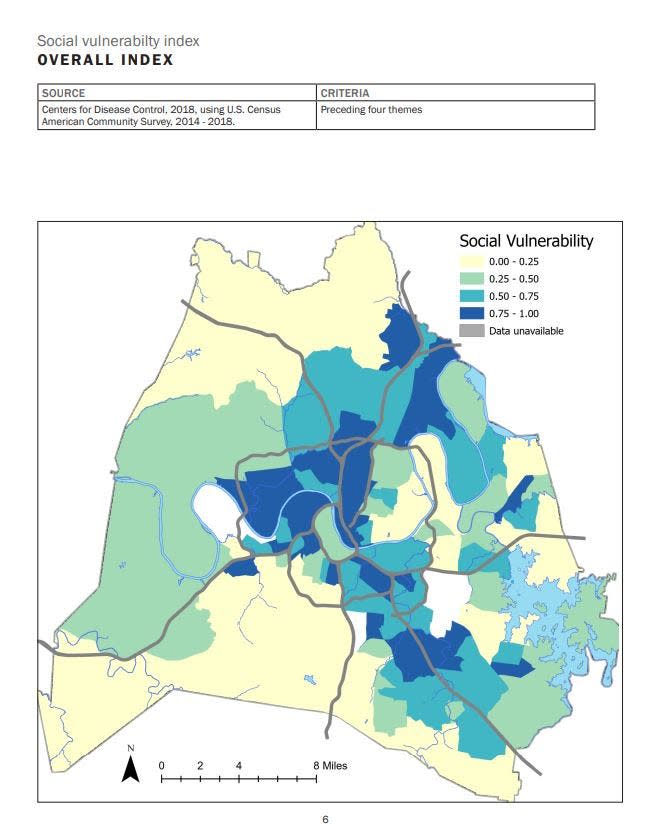Nashville residents divvy up $10M of COVID relief money, funding traffic safety, parks
A year ago, Nashville set aside $10 million in pandemic relief money for residents to pitch and select which projects those dollars would fund. Now, the votes are in, and the 24 chosen projects throughout the county include updates to public libraries and parks, traffic and pedestrian safety improvements and more.
The projects were selected through a citizen-led process called participatory budgeting, a funding model tested in multiple U.S. cities and international locales in the last decade. Funding was weighted based on community vulnerability, with $4 million in funds devoted to areas deemed most in need of disaster support.
Nashville first tested the model with two rounds of spending in North Nashville. The $10 million that powered the latest countywide round came from Nashville's $259.8 million share of federal American Rescue Plan dollars, which must be allocated by the end of 2024.
But questions over resident participation and the share of funds devoted to administering the process have raised questions about participatory budgeting's future in Nashville.
Metro Nashville has a population of around 715,885, according to the U.S. Census, and the participatory budgeting program allowed any Davidson County resident age 14 and older to vote. Of those:
12,737 people voted online (not including duplicate responses)
384 people voted via paper ballot (mailed to the Participatory Budgeting Nashville post office box or cast at countywide polling locations)
Votes came from 38 of Davidson County zip codes
"I expect if it does go forward, it will be revised pretty significantly," Mayor Freddie O'Connell said earlier this year. "Even with hundreds of thousands of dollars in marketing, we're not seeing particularly heavy voting rates on participatory budgeting."
Funded projects
Parks
$1.25 million: Bordeaux and Timothy Park improvements
$900,000: McFerrin Park improvements
$800,000: Coleman Park improvements
$425,000: Dudley Park improvements
$823,000: Whitfield Park improvements
$650,000: Antioch Park improvements
$250,000: Southeast Community Center Park improvements
Libraries
$285,000: Madison Branch Public Library improvements
$285,000: Goodlettsville Branch Public Library improvements
$335,000: Hermitage Branch Public Library improvements
Traffic and pedestrian safety
$50,000: Metro Center traffic calming
$50,000: Holt Road traffic calming
$100,000: Stratford High School bus shelter
$62,000: Terry Lane and Tyler Drive traffic calming
$1.28 million: Lebanon Pike traffic improvements
$182,000: Brook Hollow Road traffic calming
$100,000: Pedestrian safety improvements to the intersection of Harding Place and Nolensville Pike
$75,400: Tampa Drive traffic calming
$307,200: Sunnywood Drive, Oakfield Grove and Autumn Oaks traffic calming
$75,000: Hobbs Road traffic calming
Other initiatives
$500,000: Ruby Majors Elementary School and Dodson Elementary School playground improvements
$74,000: Historic markers for the 12 South/Belmont neighborhood
$160,000: Jefferson Street historical tours
$400,000: Grant funding for White Bridge Pike Apprenticeship U (a program partnering with Nashville State Community College and the Tennessee College of Applied Technology)
Administrative costs (including marketing) totaled $571,523. The remaining $9,877 in funds will be held for any additional administrative or project expenses, and if unused, will be reallocated toward other American Rescue Plan initiatives in Metro Nashville.
Vulnerable areas receive 40% of funding
The American Rescue Plan requires federal aid dollars to go toward supporting those who were most impacted by the pandemic. Metro used the CDC's Social Vulnerability Index drawn from U.S. Census variables to sort Davidson County into four vulnerability tiers, with the areas of highest disaster vulnerability receiving the most funding.
About $4 million — 40% of the available funding — went to areas with the highest social vulnerability index, including portions of North Nashville, southeast Nashville and communities in northwest Davidson County.

Other portions of north and southeast Nashville received $2.8 million toward selected projects. Downtown, portions of western Davidson County and scattered portions of eastern Davidson County received $1.5 million. The remaining $1 million went to projects in areas with the lowest social vulnerability index, including southwest Davidson County and the county's northernmost communities.
Future of participatory budgeting
Fabian Bedne, a former Metro Council member who served as Metro community development manager under former Mayor John Cooper's administration, introduced the model to Nashville through two $2 million rounds focused in the North Nashville community in 2021 and 2022.
The process was led by a steering committee of residents nominated by Metro Council members and Cooper's office, and a panel of similarly selected resident "budget delegates" determined which project ideas submitted by the public were eligible to appear on the ballot.
Critics of the process have questioned the efficacy of spending more than half a million dollars on marketing, facilitation and administration costs for the latest participatory budgeting round.
Whitney Pastorek served as the steering committee's chair for three months before stepping down due to "moral and ethical concerns" with the process, including the hiring of public relations firm Hall Strategies for countywide marketing.
O'Connell, who previously served as Council member for District 19 for eight years, said he'll be looking carefully at feedback from district Council members and participants. He questioned whether the projects funded through this model could instead be sourced through the Capital Improvements Budget, a municipal wish list of projects across the county, shaped and ranked by Metro Council members based on district resident wants and needs.
"If this was my experience, all of the things that I would have wanted in participatory budgeting I had made sure were generally in the CIB anyway, and they were things that were sourced from our neighborhoods and District 19," he said earlier this year. "So I do want to talk to council members about how they feel, if this worked, if it showed them anything about their own districts and participance of their citizens."
This article originally appeared on Nashville Tennessean: Nashville residents use $10M in COVID-19 pandemic relief money

